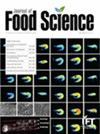Effects of four kinds of improver on fermentation characteristics of gluten-free rice dough
Abstract
Rice is commonly utilized as a wheat bread substitute due to its low allergenicity. However, rice bread faces challenges in processing efficiency and the formation of a cohesive gel network structure, resulting in suboptimal taste Hence, this study compared four improvers—trypsin, whey protein (WPC), hydroxypropyl methyl cellulose (HPMC), and molecularly distilled monoglycerides (GMSs). The impacts of the four improvers on the processing attributes of rice dough were comprehensively assessed across fermentation, moisture content analysis, rheology, heat stability, and pasting characteristics. The findings indicated that the incorporation of trypsin, HPMC, and WPC resulted in 107%, 61%, and 1% increases in gas production of fermented rice dough, respectively, while reducing the regrowth values to 564.00 ± 7.21, 176.67 ± 0.58, and 611.00 ± 3.61 cP. Notably, the air-holding capacity of HPMC-fermented rice dough exhibited a 7% enhancement. All four types of improvers raised the enthalpy of melting (ΔH) and the difference in melting point (ΔT) of fermented rice doughs, with trypsin enhancing ΔH by 44% and ΔT by 40%. GMS, HPMC, and WPC increased the degree of water incorporation in fermented doughs. This study could serve as a benchmark for enhancing the fermentation attributes of rice dough and establish a groundwork for the future advancement of gluten-free dietary options.
Practical Application
The thorough analysis conducted in this experiment provides a theoretical framework for rice dough preparation during the fermentation process, addressing the dietary needs of individuals with coeliac disease and those following a gluten-free diet. This study also paves the way for the development of improved gluten-free rice products in future research pursuits.

 求助内容:
求助内容: 应助结果提醒方式:
应助结果提醒方式:


